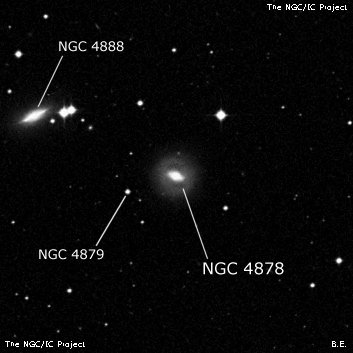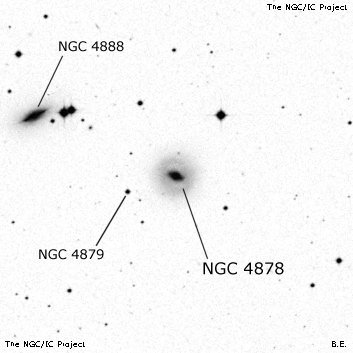NGC/IC Project Restoration Effort
(This is a very very beta version)
NGC4878


Basic Information
Location and Magnitude
Right Ascension: 13:0:20.1
Declination: -6:6:14
Constellation: VIR
Visual Magnitude: 12.9
Historic Information
Discoverer: Herschel W.
Year of discovery: 1789
Discovery aperture: 18.7
Observational
Summary description: vF, vS, p of 2
Sub-type: SB0
Corwin's Notes
=====
NGC 4878, NGC 4879, and NGC 4888. Alister Ling pointed out that my original
"short story" on N4878, N4879, and N4888 is confusing. Indeed it was. It
is also obviously one of the cases that needs more attention. So, here is a
revision.
All three NGC objects were found by WH on 23 March 1789, and all are referred
to 26 Virginis. Here are his observations:
N4878,9 III 758,9 20m 55s f, 1d 53m n Two nebulae, both vF, vS.
N4888 II 778 21m 12s f, 1d 54m n F, S, sf a double star.
JH recorded only II 778 (h1505): 12 51 46.9, -05 09 16 pF, vS, E, psbM
(1830 position)
D'Arrest has, like WH, one position for N4878,9, and another for N4888. As
always, I'm stuck on his Latin descriptions, but I can make out that there is
an 11th magnitude star 5.5s preceding, 1.5m north of his observed place (12 53
09, -05 21.3; 1861) for N4878,9. He also mentions WH's double star near
N4888; his 1861 position for that is 12 53 26, -05 19.6. Note that his
difference in positions between the objects is close to WH's: 17s in RA and
1.7m in Dec.
That is it for the pre-NGC observations. Post-NGC, I've found the following.
1) Bigourdan has eight observations each for N4878 and N4888, but could not
identify N4879 with certainty.
2) Ormond Stone also lists N4878 and N4888 as nebulae in the 1893 Leander
McCormick list (the novae here are in IC1), but has nothing about N4879.
3) Reinmuth has N4878 as an eF, eS stellar object or star (his object is a
star) 1.7' south-preceding N4879, the galaxy.
4) MCG has -01-33-064 as N4878, -064a as "4879?" (but this is a defect on the
blue POSS1), and -066 as 4888.
5) the first "edition" of ESGC put N4878 at 12 57.8 -05 50 (1950.0), and
N4879 = N4888 at 12 58.0 -05 48. When Brian Skiff measured the ESGC
positions, he followed my ESGC identifications; the second is clearly wrong
since (as I now know; ahem) WH claimed to have seen all three on the same
night.
So, it is clear that there are only two bright galaxies here. GSC has only
one (which I'll call "NGC 4878:"; note the colon), and also misses the bright
double star (which WH mentioned) just preceding N4888. There is a star in GSC
about 1.5 arcmin southeast of N4878 that I suspect is WH's second "nebula."
It is a bit closer to the galaxy than is Reinmuth's star. Here are some
positions, either from GSC, or measured by me on POSS1:
Object RA (2000.0) Dec Source Adopted identifications (source)
Star 13 00 14.4 -06 07 08 HC NGC 4878? (Reinmuth)
Galaxy 20.12 06 14.1 GSC NGC 4878: (Big, Stone, MCG, HC)
Star 25.61 06 40.4 GSC NGC 4879: (HC)
Galaxy 36.2 04 31 HC NGC 4888 (All)
The adopted identifications are based on the assumption that Herschel recorded
one of the stars south of the preceding galaxy, thinking it was a second
nebula. If he saw the preceding star, then it should be N4878, and N4879 is
clearly the galaxy. If he saw the following star -- as I believe he did (it
is brighter and nearer the galaxy than the preceding star) -- then the numbers
should be reversed: N4878 becomes the galaxy, and N4879 is the star. There
is no question about NGC 4888.
Steve's Notes
=====
NGC 4878
48" (4/2/11): this bright galaxy forms a prominent pair with NGC 4888, which is located 4.3' NE. Fairly large, elongated 4:3 ~N-S, 1.2'x1.0'. Sharply concentrated with a slightly elongated very bright core. A mag 12 star is 2' NW and a bright double star just west of NGC 4888 lies 3.5' NE. NGC 4879 may be a mag 14.5-15 star 1.4' ESE. The DSS shows a weak ring structure in the halo but I didn't see this feature.
17.5" (5/22/93): fairly faint, small, round, prominent core, almost stellar nucleus, small halo. Forms a close pair with NGC 4888 4.3' ENE.



